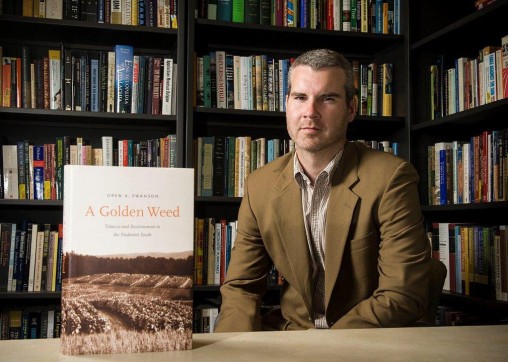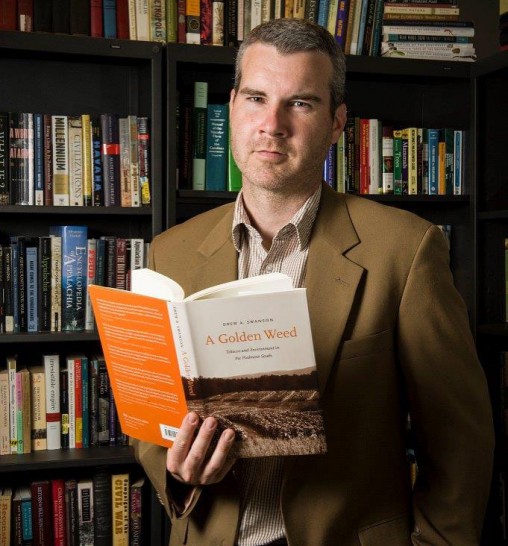
“A Golden Weed: Tobacco and the Environment in the Piedmont South,” a new book by Drew Swanson, an assistant history professor at Wright State, was named the year’s best book on agricultural history by the Agricultural History Society. (Photos by Erin Pence)
The seed was planted with the boy during a walk through the woods on his grandparents’ Virginia farm. A deep gully in the red clay that cut through the pines was a telltale sign of careless tobacco farming on fragile soil.
That early memory for Drew Swanson, Ph.D., now an assistant history professor at Wright State University, grew to a gnawing curiosity about the history of tobacco growing and how its successes and failures came to shape his boyhood home.
And that curiosity has produced “A Golden Weed: Tobacco and the Environment in the Piedmont South,” named by the Agricultural History Society as the year’s best book on agricultural history.
“I hope the book will complicate Southern history a little bit,” said Swanson, who joined the faculty at Wright State in 2013 and has taught courses that include U.S. history, Appalachian history and environmental history. “And maybe it can be a cautionary tale when we’re feeling complacent about our pursuit of sustainability.”
Swanson grew up on a small farm near Roanoke, Va. His father still farms and is also a Southern Baptist minister and semi-retired high school English teacher.
Swanson was initially interested in a career in forestry or the outdoors, so he got his bachelor’s degree in biology from Lees-McRae College in Banner Elk, N.C. After graduation, he worked as a park ranger at Grandfather Mountain, which is part of the Blue Ridge in North Carolina.
“I did trail construction, law enforcement, studied endangered species,” he said. “The only problem is you are ice- and snowbound for much of the winter. I got a little stir crazy.”
So Swanson decided to return to academia and got his master’s degree in history from Appalachian State University and his Ph.D. from the University of Georgia, where he studied environmental history.
“A Golden Weed” sprang from Swanson’s dissertation at Georgia and his postdoctoral fellowship at Millsaps College in Jackson, Miss.
Swanson wanted to unearth the history of the Piedmont region of Virginia and North Carolina to figure out how it had gone from a wealthy, tobacco-farming region to a largely impoverished landscape and population.
“What I found was a horrible irony that during these steps on the road to poverty, the farmers thought they were doing something sustainable,” he said. “They genuinely viewed their tobacco crops — a particular variety called Bright Leaf, which is the core ingredient for cigarettes in the 20th century — as something that would give them a sustainable lifestyle.”

In “A Golden Weed,” Drew Swanson unearths the history of the Piedmont region of Virginia and North Carolina and how it went from a wealthy, tobacco-farming region to a largely impoverished landscape and population.
While Bright Leaf performed well in soil whose fertility had been significantly depleted by previous tobacco varieties, the soil continued to erode. And by the time farmers began relying on synthetic fertilizer in the late 1800s, it was too late.
“Then it becomes the classic Southern story — reliance on a commodity crop, debt peonage, an inability to sustain your situation,” Swanson said. “They largely destroyed the landscapes they relied on. They still raise tobacco in portions of this region today, but they do it with really high fertilizer inputs and a lot of spraying so that the profits are very low.”
Swanson began research on the book in 2006, looking for answers in archives, microfilm, book collections, letters, diaries, daybooks and farm journals.
“This is a history looking from the tobacco field outward, exploring farmers’ views of the world,” Swanson writes. “It is an effort to take their claims and their environmental understandings as seriously as they did and to recover a world that has been all but lost.”
Swanson was surprised at how much money could be made by growing tobacco.
“There was the potential to become genuinely rich if you put all of the pieces together,” he said. “One farmer in 1856 reportedly made the equivalent of 30 years’ salary in one year. There was a bit of this Gold Rush fever, this lottery fever that inspired farmers and made them a little crazy.”
One newspaper even put a local farmer’s big tobacco crop on the front page and buried on Page 2 the historic news of John Brown’s raid on Harper’s Ferry, an attempt by the white abolitionist to start an armed slave revolt by seizing an arsenal.
“This is a story of the rise of a crop culture, but it is also a tale of the decline of the environment that accompanied this form of tobacco cultivation, from severe erosion to deforestation to insect infestations,” Swanson writes.
In addition to the Agricultural History Society honor, Swanson won the Ohio Academy of History’s 2015 Publication Award for junior faculty at Ohio universities.
He hopes the book is a lesson for the future.
“It’s not that pursuit of sustainability is bad, but our understanding of sustainability is always incomplete,” he said. “So we can end up in weird places out of good intentions.”

 Wright State Police Department delivers major donation to Raider Food Pantry
Wright State Police Department delivers major donation to Raider Food Pantry  Wright State engineering and computer science students earn prestigious federal SMART Scholarships
Wright State engineering and computer science students earn prestigious federal SMART Scholarships  Wright State Police Chief Kurt Holden selected for prestigious FBI National Academy program
Wright State Police Chief Kurt Holden selected for prestigious FBI National Academy program  Wright State’s Raj Soin College of Business ranked among the best for entrepreneurs by Princeton Review
Wright State’s Raj Soin College of Business ranked among the best for entrepreneurs by Princeton Review  Wright State’s annual Raidersgiving draws hundreds
Wright State’s annual Raidersgiving draws hundreds 